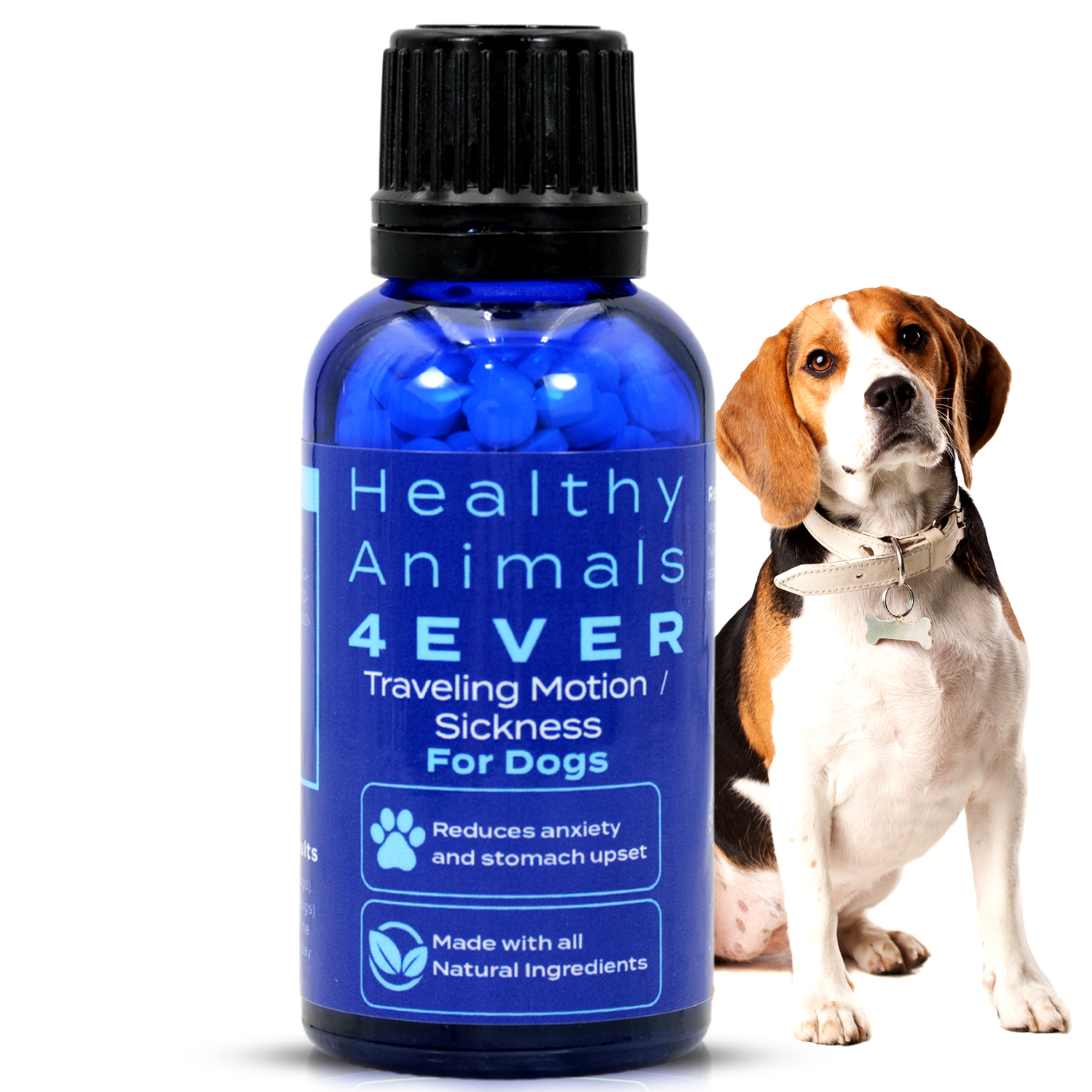Dealing with Canine Motion Sickness: Understanding, Preventing, and Treating
When you think about going on a trip to a beautiful destination for a few days, you want your dog to be a part of that perfect picture. Embarking on a journey in the car with their family is an enjoyable adventure. However, these trips can become nightmares for dogs that experience motion sickness, no matter how attractive the final destination is.
What exactly is motion sickness, and what causes it? What are the symptoms and treatment options? Is it something you can prevent?
Let's answer these questions individually and ensure that your next trip with your dog is a safe and an enjoyable experience for everyone.

What is motion sickness in dogs, and what causes it?
Motion sickness in people is feeling sick when traveling by car, boat, plane, or train. Unfortunately, our pets can be affected by motion sickness, too. A common type is caused by dogs traveling in a car, and sometimes people refer to it as dog car sickness or dog motion sickness.
Now, what is the reason for your dog to get motion sickness? Dog motion sickness is primarily seen in puppies because the ear structure used for balance isn't entirely developed in young dogs and puppies.
You can read more about dogs' ears here: https://www.carecredit.com/well-u/pet-care/10-things-dogs-ears/
Ear structure in puppies is the main reason for dog motion sickness. We can see it in older dogs but not as often as in puppies and young dogs. Not to say that all dogs will outgrow travel sickness, but many of them will. If the first few car rides of a dog's life left them nauseous, they are conditioned to associate travel with vomiting, even after their ears have entirely developed.
Travel sickness can also be caused by stress, so if your dog has only ridden in the car to go to the vet, they may associate every car ride with the vet. That connection can cause travel sickness even when the dog grows up.
To sum it up, the main reason for motion sickness in puppies is the physiology of their ears which aren't fully developed, but some dogs will never outgrow it because of bad experiences they had as puppies.
How to detect motion sickness?
When people are experiencing motion sickness, you can easily spot it by the green color of their faces. In dogs, we must recognize some other symptoms of travel sickness.
These are some of the most common signs we can spot:
- Inactivity - Your dog goes from excited and happy to inactive while traveling by car. You can easily see that his mood has switched.
- Yawning - As soon as your dog gets in the car, he yawns. Excessive yawning isn't a sign of tiredness. It's the first sign of travel sickness.
- Whining - Dogs commonly whine when seeking attention, but when complaining in the car, they could suffer from motion sickness.
- Excessive drooling - If your dog is drooling, it could mean (s)he is nauseous. In the case of dog travel sickness, drooling is a clear sign that a car ride makes them feel sick.
- Smacking or licking lips - Dogs lick their lips as a gesture when they are feeling threatened or when they experience a problem such as nausea. If your dog does it while driving in the car, it's a sign of travel sickness.
- Vomiting during the car ride is the last sign that your dog is car sick. If your dog is vomiting during the car ride, you should immediately seek solutions or treatment that we will discuss later.
How to prevent motion sickness?
Car sickness can be a huge problem for dogs and dog owners. We all want our puppies to be happy and feel good. The best way to deal with motion sickness in dogs is to prevent it if possible. The goal is to teach your puppy that the car ride is something pleasing that will bring him joy and reward and gradually adjust him to longer car rides.
So let's break the strategy into steps and ensure that your new puppy gets used to car rides as soon as possible.
Step 1.
Put your puppy in a car for the first time without turning the engine. Sit with him in the back seat and stay like that for 1 minute with the car doors opened. After you exit the car, reward him for his first car experience and make him feel good about being in the car for the first time.
Step 2.
The day after you do step 1, you should put your puppy in the car again, but this time close the doors and focus on teaching him good car habits. Try to teach him where he should sit and how he should behave in the car. You should prolong your stay in the car for 2 or 3 minutes. After you finish the exercise, again reward your dog.
Repeat step 2 a few days in a row until your dog is comfortable staying in the car and thoroughly pleased with behaving in the car.

Step 3.
Put your dog in the car, turn the car engine on, and ensure that your dog is still comfortable and behaving well. Let the car engine run for 3 or 4 minutes, and after you exit the car, reward your dog abundantly.
Please repeat this step for a few days until your dog is comfortable.
Step 4.
After your puppy is comfortable sitting in the car with the engine on, it's time for the first short ride. Make sure your dog is in his place and drive a car for 1 minute. Periodically look at his behavior and reward your puppy with treats, petting, or anything else he enjoys. Again, it would be best if you repeated these short 1-minute rides until your dog is completely comfortable and satisfied with them.
After a few tries, you can make rides 2-3 minutes long.
Step 5.
It's time for the first real ride. Please choose a destination close to your home where your dog will enjoy itself. It can be a park, forest, or dog playground. Whatever your puppy finds exciting and enjoyable. Put your puppy in the car and prepare for the ride. At this point, they should be comfortable with the ride, which shouldn't be challenging. After you arrive at the destination, reward him appropriately. Stay there for a while and return home with the same procedure and rewards.
Repeat these short trips for a few days until your dog is comfortable and relaxed.
Step 6.
After your dog is comfortable with 10-minute rides, you should try longer trips. Slowly introduce them to longer car rides, and don't forget to treat them well for good behavior.
Soon your puppy will be ready for long trips with your family without any issues.
If your puppy is not reacting well to the new step you are introducing and you can see signs of motion sickness, you should repeat the previous step until your dog is comfortable.
Most importantly, don't let your puppy associate car rides with something scary like going to a vet. Teach him to associate car rides with good outcomes like treats, petting, running, or playing with other dogs.
How to treat motion sickness?
If your puppy or dog already has motion sickness, you should learn how to treat it.
Along with appropriate medicine (more on this later), you should teach your dog that car rides are something they will enjoy and try to remove the fear of motion sickness from them.
To prevent motion sickness, follow the same steps you would use for training dogs that already have motion sickness, but you need to be more careful with them and give them more time to adjust.
As I said before, puppies have anatomy problems that cause motion sickness, but most issues with older dogs come from bad experiences with car rides. When training a dog with motion sickness, always give them enough time to accommodate every step of this process. Time, patience, good training, correct plant-based medicine, and rewards they like should significantly improve the symptoms.
Tips for preventing and treating car sickness
-
Be careful with what your dog sees. Watching the world speed by in a blur through a window can make anyone feel nauseated.

- Place your dog or puppy in the middle seat in the back so he's more likely to look forward and not to the side windows.
- Use a dog seat belt to keep them safely in place. For more about the advantages of dog seatbelts, you can read this article: https://www.rover.com/blog/dog-car-seat-belts/
- If you think your dog is going to vomit, stopping the car and taking him for a walk may help temporarily relieve his stress.
- Lower the car window. Even a few inches will equalize outside and inside air pressure, which will help reduce nausea.
- Keep the car cool and ventilated.
- Restrict your dog's food intake before the car ride. If possible, don't give your dog food for 10 hours before the trip but never restrict access to water!
- Bring something that smells like home. His favorite toy, his favorite blanket, or even some of your clothes will give him a home-like feeling.
- Buy a special toy that you only give to the dog in the car. It will help him associate car trips with something fun.
What is the best medicine for motion sickness?
When we talk about medicine for travel sickness, many solutions will help your dog deal with car sickness, but the best and healthiest option possible is something natural that doesn't have side effects.
Traveling/Motion Sickness is the most effective way of helping your dog deal with car rides. It is a natural, plant-based remedy manufactured especially for dogs suffering from this problem. Give your dog about five pellets before the car ride, and your dog will stay calm and enjoy the car ride.
Another solution for dogs suffering from car rides is to deal with the anxiety a dog feels when they go for a ride.
If your dog is visibly feared of car rides, treat him with "dog anxiety bm17" before every trip, and you will be positively surprised by the effect of this natural and effective cure.
Bottom line
Dog motion sickness is a problem that affects many dogs. Luckily, with proper training, you can prevent dog motion sickness. With suitable medication or supplements, combined with letting your dog get used to car rides, your dog will enjoy and be happy on family trips.
In severe cases of dog travel sickness where the above-mentioned steps and medication are not effective, you should seek help from your veterinarian.










